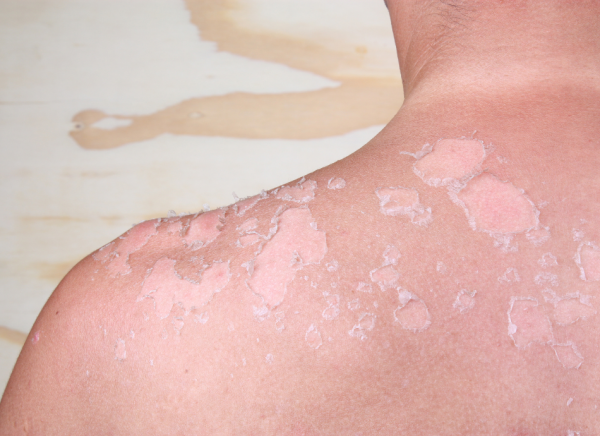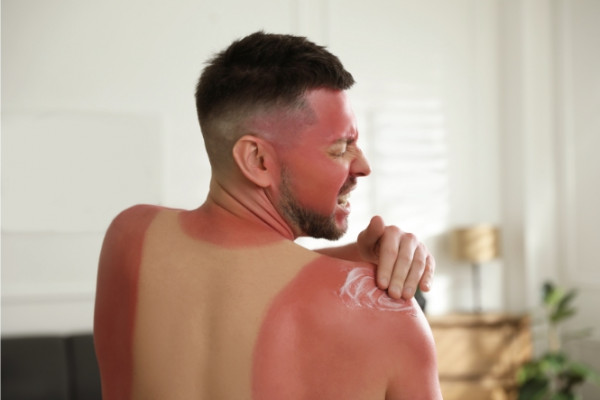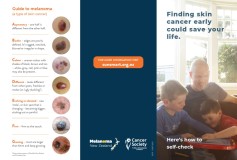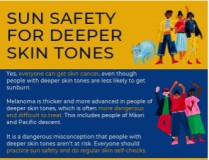Wishing everyone a safe and happy Christmas and New Year – Meri Kirihimete from the Healthify team.
Sunburn
Key points about sunburn
- Sunburn is a burn to your skin caused by too much exposure to ultraviolet (UV) radiation from the sun.
- It can also be caused by other sources of UV, such as sunbeds and tanning booths.
- Each time you expose your skin to UV radiation, you increase your risk of developing skin cancer.
- Mild sunburn can be treated at home but see your healthcare provider if you or your child over the age of 12 months has severe or blistered sunburn.
- If your pēpi under 1 year of age is sunburned seek medical help.

Sunburn is your skin’s reaction to ultraviolet (UV) radiation from the sun. Your skin reacts to too much UV radiation by releasing chemicals that swell your blood vessels. This causes fluid to leak and your skin to become red and inflamed – what we call ‘sunburn’.
UV radiation can pass through cloud, and levels can be as high on cooler, cloudy days as they are on hot, sunny days. That’s why it’s important to cover your skin and use sunscreen when you’re outside regardless of the weather.
UV damages your skin cells and infrared energy and heat from the sun causes actual burns and blisters. The longer the exposure the greater the damage done. When your skin peels after you’ve been sunburnt, that’s the dead cells peeling off. However, the new cells underneath may have had their DNA damaged by the earlier UV exposure. This increases the chances of developing skin cancers.
Test your knowledge of sun smart facts on the SunSmart site.(external link)
As well as light and heat, the sun gives out invisible UV radiation.
There are 3 types of UV radiation – UVA, UVB and UVC. Nearly all UVC radiation is absorbed by the earth’s atmosphere before it reaches us. UVA and UVB radiation are both involved in causing sunburn.
- UVA – penetrates deeper into your skin and can lead to roughness, dryness, wrinkles and sagging skin.
- UVB – causes tanning, burning, ageing and skin damage and is much more significant in the development of skin cancer.
Levels of UV radiation from the sun are always changing. The Sun Protection Alert(external link) is a handy tool that lets you check the time each day that you should protect your skin and eyes from UV.
Also see the uv2Day app that shows ultraviolet index (UVI) information all over Aotearoa New Zealand – its peak value and progression throughout the day at your current location.
The fairer your skin the higher your risk of getting sunburnt. However, while dark brown or black skin rarely burns, skin of any colour can be damaged by UV radiation. It’s important to realise that all types of sunburn, whether mild or serious, can lead to permanent skin damage and lay the groundwork for skin cancers to develop.
Sunburn damages your skin, causing premature ageing, and increases your risk of developing certain types of skin cancers in later years.
Skin cancer, including melanoma, is Aotearoa New Zealand's most common cancer. According to SunSmart(external link), skin cancers account for 80% of all new cancers each year. Melanoma is the most dangerous type of skin cancer, with more than 2000 reported in Aotearoa New Zealand each year. As well as melanomas, over 80,000 other skin cancers are treated annually.
DermNet(external link) says that having 1 blistering sunburn at least doubles your chances of developing skin cancer later.
Signs of sunburn can vary depending on skin type and the length of time you were exposed to UV rays. The main signs of sunburn include:
- red skin that's hot to touch
- pain and/or itching skin
- swelling
- fluid-filled blisters that might itch or break
- broken blisters or peeling/flaking skin that reveals even more tender skin underneath.

Image credit: Canva
Severe sunburn can cause chills and fever, dehydration and serious complications. The signs of sunburn can start in as little as 11 minutes and skin can turn red within a few hours of being burnt. Sunburn continues to develop, sometimes for up to 24 to 72 hours. Depending on how bad your sunburn is, it can take days or weeks to heal.
See your healthcare provider or go to the nearest emergency clinic if you (or your child over the age of 12 months) have:
- very bad sunburn with pain and extensive blistering
- a headache
- nausea (feeling sick) or vomiting (being sick)
- a fever (high temperature)
- dizziness or feeling ‘out of it’.
If your baby under 12 months of age is sunburned take them to be checked by a health professional.
There’s no cure for sunburn except time, but there are things you can do to help while your body heals:
- Stay hydrated by drinking plenty of water.
- Bathe in cool water or gently apply cold compresses or flannels.
- Avoid using soap, which might irritate it, and pat your skin dry afterwards.
- Talk to your local pharmacist about products that soothe sunburn and help it heal.
- Take over-the-counter pain relief like paracetamol or ibuprofen if you need to and are able to take those medicines.
- If your skin can bear it, keep it moisturised to help with itching. A moisturiser containing aloe vera can help to soothe sunburnt skin. It won’t stop your skin from peeling but might moisturise the skin beneath. Don’t apply butter or oil-based creams to sunburnt skin.
- Don't pop blisters or be tempted to peel off pieces of your skin, as you may get a skin infection. Just let the dead skin come off on its own. When it’s detached, remove it carefully without ripping more off.
- Keep your skin out of the sun until it’s fully healed.
- Severe sunburn may require special burn cream and burn dressings. Very occasionally, hospital treatment may be needed.
- If in doubt, see your healthcare provider or emergency clinic.

Image credit: Canva
- A lukewarm bath may help to soothe their skin.
- Paracetamol might provide some pain relief for severe cases. Make sure you give the correct dose of paracetamol for your child’s age. Use our paracetamol dose calculator to find out how much to give them.
- Sunburn can cause dehydration, so give your child water to replace body fluids.
- If your baby is less than 1 year of age, take them to your healthcare provider to be checked.
- If your pēpi is older than 1, call your healthcare provider if they’re in severe pain, blistering, feverish, or are lethargic (don't seem fully responsive).
- Keep them out of the sun entirely until the sunburn heals.
Find out more on the Plunket website(external link).
Being SunSmart is about covering up with clothing, a broad-spectrum sunscreen, a hat, and sunglasses. Remember to SLIP, SLOP, SLAP and WRAP.
- SLIP into a long-sleeved shirt and into the shade. Generally, fabrics with a tighter weave and darker colours will give you greater protection from the sun. There are also certain fabrics on the market that have an SPF rating.
- SLOP on plenty of broad-spectrum sunscreen of at least SPF30+. Apply sunscreen at least 20 minutes before going outdoors and reapply every 2 hours. Read more about using sunscreen or watch the video below.
- SLAP on a hat with a wide brim or a cap with flaps. More people get sunburned on their face and neck than any other part of the body.
- WRAP on a pair of wrap-around sunglasses. UV radiation is just as dangerous to eyesight as it is for your skin.
If you work outdoors (eg, as a farmer, road-worker or tradesperson) talk to your employer about workwear that protects you from the sun or look for garments with UPF – ultraviolet protection factor.
Read more about sun safety and workplace safety.
Some people have concerns about low vitamin D levels due to recommendations to avoid sun exposure. Vitamin D can be safely replaced if needed, and damage from the sun is far more likely to cause serious health problems. Please talk with your healthcare provider if you're concerned about your vitamin D levels and continue to practice sun safety. Read more about vitamin D and sensible sun exposure.

Image credit: Healthify He Puna Waiora
Video: Are you applying your sunscreen correctly?
(Melanoma New Zealand, 2020)
Sun protection alert
The Sun Protection Alert (SPA) is available from September to April (daylight savings months). It tells you what times sun protection is required for wherever you are in Aotearoa New Zealand.
Check the SPA information on the MetService website(external link) and the MetService weather app(external link).
The Sun Protection Alert is available in all daily newspapers throughout the country as well as on the MetService, SunSmart and most news websites during daylight saving months.
SunSmart NZ(external link) Cancer Society, NZ
Sunburn(external link) Better Health Channel, Australia, 2021
Sunburn(external link) DermNet, NZ
Sunbeds(external link) Health New Zealand | Te Whatu Ora
Brochures
Be sun smart(external link) Health Promotion Agency, NZ
Skin cancer self-check(external link) Cancer Society NZ
Sun safety for deeper skin tones(external link) Cancer Society NZ
Apps/tools
Skin care (dermatology) apps
Sun protection alert(external link) SunSmart, NZ, tells you the time each day that you need to protect your skin and eyes
References
- Sunburn(external link) Better Health Channel, Australia, 2021
- SunSmart(external link) Cancer Society, NZ, 2023
- Sunbeds(external link) Health New Zealand | Te Whatu Ora
- Sunburn(external link) DermNet, NZ, 2005
- How to treat sunburn(external link) American Academy of Dermatology, US, 2023
Abels, P, et al. Companion statement on vitamin D and sun exposure in pregnancy and infancy in NZ(external link) Ministry of Health, NZ, 2012
Reducing the burden of melanoma in New Zealand – prevention and risk assessment(external link) BPAC, NZ, 2020
See our page on skin cancer for healthcare providers.
Brochures

Be sun smart
Health Promotion Agency, NZ

Skin cancer self-check
Cancer Society NZ

Sun safety for deeper skin tones
Cancer Society NZ
Credits: Healthify editorial team. Healthify is brought to you by Health Navigator Charitable Trust.
Reviewed by: Dr Sara Jayne Pietersen, FRNZCGP, Auckland
Last reviewed:





